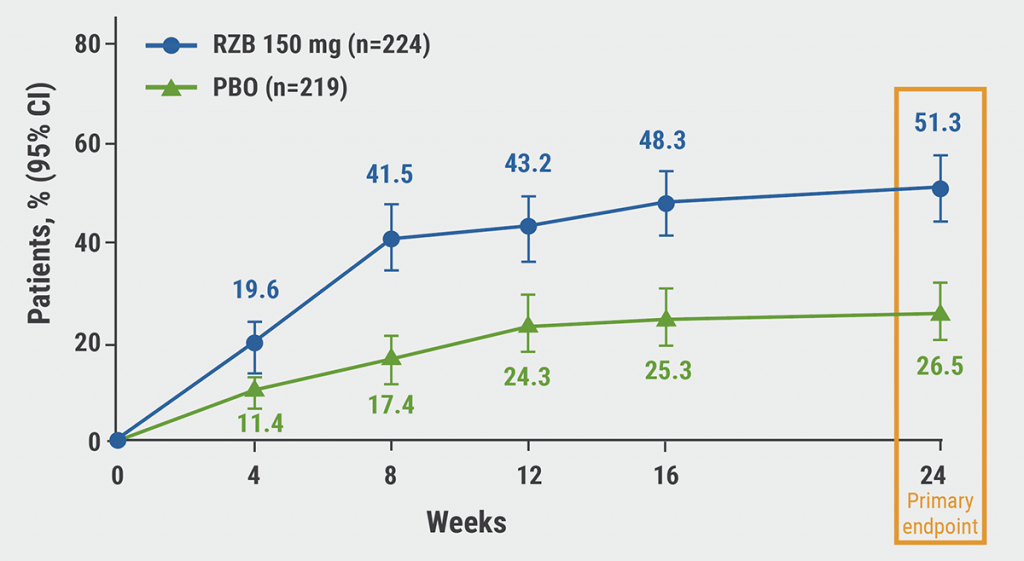PRP is defined as a portion of the plasma fraction of autologous blood with a platelet concentration above baseline. However, as Prof. Ronda S. Farah (University of Minnesota, MN, USA) emphasised, its use in androgenetic alopecia is questioned: the first problem is that no standardised protocol for preparing PRP exists. PRP probably acts by growth factors that stimulate and inhibit hair growth (see Figure). Platelets can be activated before application of PRP, but whether this is necessary is a matter of debate. In addition, there is no clear PRP regimen; most users recommend monthly injections with a possible booster about 6 months later.
Figure: Activated platelets release several growth factors that may be responsible for the treatment effect of platelet-enriched plasma [1]

SG, sebaceous gland; B, bulge region; HS, hair shaft; DP, dermal papilla; PDGF, platelet-derived growth factor; EGF, epidermal growth factor; FGF, fibroblast growth factor; VEGF, vascular endothelial growth factor; IGF, insulin-like growth factor; TGFβ; transforming growth factor β.
The side effects of PRP include pain at the injection site. “Massage the area or distract the patient to alleviate pain,” Prof. Farah recommended. She applies PRP specifically to the thinning regions.
In a real-world study, PRP combined with 5% minoxidil led to a positive response in 71% of patients at 2 months: the PRP combination demonstrated a significant increase in hair density. In a randomised controlled split-scalp study including 35 patients with androgenetic alopecia, one side of the scalp was treated with PRP and the other with a saline solution as placebo. Hair density increased on both sides, but this difference failed to reach statistical significance [3]. In a systematic review, 84% of studies demonstrated a positive effect, but only 50% had objective measurements [4]. The authors concluded that PRP is efficient and well tolerated. Simultaneous use of PRP and minoxidil demonstrated the highest rate of improvement and satisfaction [4]. PRP proved also effective in women with androgenetic alopecia [5].
Prof. Farah stressed that additional research with standardised PRP protocols is needed. There are several questions concerning the ideal volume or platelet concentration to inject. “One should disclose to patients that it is an off-label treatment,” Prof. Farah recommended.
- Farah R. Evidence based summary of photobiomodulation and platelet rich plasma. Session S0017, AAD VMX 2021, 23-25 April.
- Ho A, et al. J Am Acad Dermatol 2020;82(2):478-9.
- Shapiro J, et al. J Am Acad Dermatol 2020;83(5):1298-1303.
- Roohaninasab M, et al. Dermatol Ther 2021; e-pub 09 January 2021.
- Dubin DP, et al. J Am Acad Dermatol 2020;83:1294-7.
Copyright ©2021 Medicom Medical Publishers
Posted on
Previous Article
« ‘Maskne’ – How can it be managed? Next Article
IL-17 inhibitor effective in axial manifestations of psoriatic arthritis »
« ‘Maskne’ – How can it be managed? Next Article
IL-17 inhibitor effective in axial manifestations of psoriatic arthritis »
Table of Contents: AAD 2021
Featured articles
Letter from the Editor
Late-Breaking Abstracts
Small molecule effective in moderate-to-severe psoriasis
Bruton’s tyrosine kinase inhibition promising for pemphigus vulgaris
Bimekizumab superior to secukinumab in psoriasis
Etrasimod – a new mode of action for treatment of atopic dermatitis
Women at higher risk for dermatologic side effects during immunotherapy
Novel easy-to-use foam formulation clears scalp psoriasis in one-third of patients
Anti-cholinergic gel demonstrates superior long-term tolerability and efficacy in axillary hyperhidrosis
Psoriasis – The Beat Goes On
Psoriasis: The treatment armamentarium continues to grow
Psoriasis management in times of COVID-19: the knowledge is growing steadily
Lower burden of high-risk atherosclerotic plaques in psoriasis patients treated with biologics
COVID-19: What Dermatologists Need to Know
Psoriasis and hidradenitis suppurativa during COVID-19: keep calm and carry on
COVID-19 in children – cutaneous involvement is common
Cutaneous reactions after COVID-19 vaccination: an update
Novel Developments in Sun Protection
Sunless tanning and other developments in sun protection
What Is Hot in Atopic Dermatitis
Comorbidity is common in adult and paediatric atopic dermatitis patients
Significant improvements in the system armamentarium for AD treatment
Topical pan-JAK inhibitor cream safe and efficacious in atopic dermatitis
Hairy Matters – What Is New in Alopecia
Allergies: an underrated factor in alopecia pathogenesis
Botulinum toxin A: a contradictory role in hair loss
Platelet-rich plasma in androgenetic alopecia – hype or hope?
Acne – New Developments
New therapeutic options add value to current acne treatment
Nicotinamide and probiotics can support acne therapy
Pearls of the Posters
Related Articles
July 31, 2023
PsA patients: highest risk of developing NAFLD

© 2024 Medicom Medical Publishers. All rights reserved. Terms and Conditions | Privacy Policy
HEAD OFFICE
Laarderhoogtweg 25
1101 EB Amsterdam
The Netherlands
T: +31 85 4012 560
E: publishers@medicom-publishers.com

